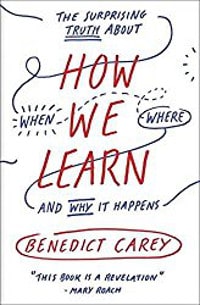I’m a margin writer. A highlighter. An underliner. A dog-ear bender. It’s one of the main reasons that I still prefer physical books to e-readers. It helps me absorb what I’m reading, and to find the key lessons again later.
I’ve learned that there’s an even better way to truly retain and understand what I’ve read however. To teach is to learn twice said Joseph Joubert. I think he was right. Tasking myself to explain something, to write about it, always seems to make my gaps in knowledge obvious. This forces me to dig back into the material to fill those holes. The practice always leaves me with a much fuller, and longer lasting understanding of the topic.
Knowing this, I’ve decided to make an earnest attempt to write up a synopsis of all the best books I read. What better book to start with than one about How We Learn!
In the current age of constant technological progress, one thing is certain. Our ability to keep up is based on our ability to learn. This makes learning to learn one of the most important things modern humans can possibly do. Author Benedict Carey comes to the rescue in How We Learn with The Surprising Truth About When, Where, and Why It Happens. As a student of learning, a lot of what it contains wasn’t revolutionary. It’s far from common sense, however, and I was totally blown away at the amount of hard science and practical advice. This is one of those books that explains things so well, after reading it you think you’ve always known them.
What’s more, the book itself recommends self examination through performance (like writing a blog post), so it was clear that it had to be the first topic in what I hope to make a series of book synopses. In these posts I plan to document my key takeaways, with some of my own thoughts or experiences woven in. Think of this as “Chris’ notes” but don’t rely on them being adequate for a school book review.
Foundations
How we learn is predicated by how we think. Benedict Carey recognizes this by starting us off with an introductory section on “Basic Theory.” These first two chapters give us a foundation of brain biology and cognitive science on which the rest of the book builds.
One of the key elements in my understanding of myself and my reality is that our brain, our mind, is constantly making up stories. Constantly. This is true both in real time and in memory recall. When you remember something, you aren’t pulling a file from a folder; you’re re-constructing the story from a set of patterns stored in the brain. What may be more startling is that using our memory – telling our stories – actually changes our memory, typically for the better.
This has to do with the fact that memory is really made up of two strengths. Storage strength is the ability to store information. Retrieval strength is the ability to recall that information when it’s needed. I’m sure you can see that memorizing something would be pretty useless without being able to remember it later! The surprising thing about these two strengths for me is that retrieval is really much more important than storage. Yes, intentionally remembering things is important, but apparently our brains have “more than enough [storage volume] to record every second of a long life, cradle to grave.” This is in direct contradiction to my previous fear that Sherlock Holmes was correct in thinking that the mind is like an inelastic attic, where eventually some memory must be cast out to make room for new ones. Great news!
The downside is that retrieval strength is more “fickle” than storage strength, and frankly a bit hard to understand at times. This is where the Forget to Learn theory comes in. The first key here is that our memory actually has two tendencies. Not only do memories tend to fade over time (decay), they also tend to come back to us when least expected (reminiscence). As Philip Boswood Ballard wrote in 1913: “We not only tend to forget what we have once remembered, but we also tend to remember what we have once forgotten.” I know that’s been true for me! But how do we use these tendencies in our own learning? It turns out that remembering things makes them easier to remember. Think of it as exercise for your brain. Just like picking up a weight and putting it down can build physical strength, forgetting and then remembering something can build retrieval strength. This practice makes our memories, our knowledge, easier to recall on demand.
“Basic” Learning
The next section in Carey’s book is titled “Retention.” What I’m calling basic learning is the kind that doesn’t require much creativity. This is the realm of memorization, test taking, studying questions with answers that are either right or wrong. We’re learning stuff that someone else discovered and documented for us. Here the book gives us three chunks of solid, practical advice for how to ingest information more efficiently.
It turns out that we absorb a lot more than just the material we’re studying. Environmental cues are having an affect on us even if we don’t notice them. These are things like music, sirens, wallpaper, and rustling trees. All of this context builds up around the core information and creates triggers that can help us with retrieval. Since you can’t predict where or when you’ll need some vital fact, the best course of action is to vary your study environment as much as possible. The more contextual cues you have, the easier retrieval will be – under any circumstance.
I touched on “the power of forgetting” (forget to learn) above, and that was no accident. We’ve all crammed for a test that snuck up on us, and we’ve all promptly forgotten most of what we crammed. In order to build lasting knowledge, cramming it into our brain’s storage isn’t enough; we need to build the ability for retrieval when it matters. Break up your studying into multiple sessions with intentional gaps in between to provide the time you need to forget just enough that the next study session really builds that memory muscle. According to Carey, “it’s best to review the material one or two days after initial study; then a week later; then about a month later.”
The best tool we have for studying is, perhaps counter-intuitively, testing. If you’re keeping up, this probably makes sense at this point. Classic retrieval strength training by “forgetting to learn.” William James opined that “A curious peculiarity of our memory is that things are impressed better by active than by passive repetition.” Anyone who’s ever tried out for a role in a play has likely experienced this first hand. Reciting your lines from memory, even a faltering memory, will get you to flawless performance much faster than simply reading them over and over. The ideal ratio of studying to testing (memorizing to recalling) is apparently about 1:2. That’s right, you should only be spending about a third of your time studying, the rest is better served self-testing! Don’t forget, performance is a great form of self testing; in order to explain the material to someone else, you must know it well.
Beyond Studying
After providing some solid study tips, Carey takes us into the realm of creativity; art and innovation. Problem Solving as he calls it, is different from other learning because we are seeking answers that aren’t intuitive or obvious. This could be answering a riddle, devising a mathematical proof, or writing a book, etc. Here he cites Graham Wallas‘ four “stages of control” as the natural flow of this kind of thinking:
- Preparation – Actively working on the problem until you’ve completely exhausted yourself, you have no more ideas left.
- Incubation – You take a break, and let your thinking go off-line.
- Illumination – The “aha” moment.
- Verification – Check to make sure the revelation is real.
One of the key ideas here is that the incubation period, where our stop actively thinking about the problem and let your subconscious wrestle with it for a while, is crucial. This is often when our mind is able to let go of assumptions and biases that were stopping us from seeing the answer.
One of the reasons that this “percolation” of ideas can happen while we are taking a break (incubating) is that unfinished work sticks in the mind. Setting a goal sets our intention, and interrupting our work creates tension that keeps that unfinished goal top of mind – it tunes our awareness. This primes us for synchronicity to strike. This is related to the Zeigarnik effect, which we can take advantage of by following the pattern: Start immediately (don’t procrastinate), Stop when you get stuck (let the subconscious take over), and then practice conscious reflection (listen to what you think) to pull the insights together.
Carey also highlights the idea of interleaving (varied practice) to build widely applicable (general) skills. Rather than focus on a single area of study at a time, mixing it up can take advantage of many of the skills taught earlier in the book as well as providing training on discrimination; the ability to identify the type of problem and how to solve it. What’s more, learning many skills together can highlight the distinctions and similarities between them, which gives us a clearer grasp of each one. Essentially we can prepare for the unexpected by using the unexpected to prepare!
Going Deeper
Carey closes out the book with a peek even further into the subconscious. He covers the idea of perceptual learning (learning without thinking), the importance of sleep (learning with my eyes closed), and the evolutionary path of our minds (the foraging brain).
In the end, we learn that concentration simply does not look or feel like we’ve been told that it does. Distraction and diversity are just as important to learning as focus and consistency, perhaps even more crucial.
This post originally appeared on Modern Autodidactism.








I must say, what an awesome read this was!. I am currently studying for my CCNA and was searching online for various articles and examples of IPv6 NDP and SLAAC. Found your article and to my surprise, the depth and simplicity together make this a definite go to reference for me in my future studies. Good job on the site, lots of valuable information
[…] was struck by particular key words, phrases, and concepts supporting and defining each force. Being a proud margin scrawler, I quickly began noting these little jewels on the title page of each chapter, as reminders, or […]